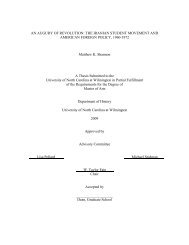Saprolegnia - The iLumina Digital Library
Saprolegnia - The iLumina Digital Library
Saprolegnia - The iLumina Digital Library
Create successful ePaper yourself
Turn your PDF publications into a flip-book with our unique Google optimized e-Paper software.
It would appear on the surface that <strong>Saprolegnia</strong> uliginosa is a relatively rare<br />
species. One of the Norwegian isolates in our collections is latent in the development of<br />
its sporangia and the sexual apparatus, and grows very slowly in water culture. This<br />
suggests that the species may be overgrown quickly by more rapidly developing<br />
species, and thus not appear at all in gross cultures.<br />
<strong>The</strong> description and illustrations of a <strong>Saprolegnia</strong> sp. recovered by Shibuya (1959)<br />
suggest that he may have collected Johannes’ species, but we cannot be certain; we<br />
include the Japanese record as an unconfirmed one.<br />
CONFIRMED RECORDS: -- GERMANY: Johannes (loc. cit.). ICELAND: Howard<br />
et al. (1970:77, fig.37). INDIA: J. N. Rai and Misra (1977b:76, fig. 3c). UNITED STATES:<br />
Seymour (1970:47, figs. 78-84).<br />
RECORDED COLLECTION: -- JAPAN: Shibuya (1959:149, fig. 4)().<br />
SPECIMENS EXAMINED: -- ICELAND (1), NORWAY (2), TWJ. UNITED<br />
STATES (5), RLS.<br />
<strong>Saprolegnia</strong> furcata Maurizio<br />
Z. Fischerei und deren Hilfswiss. Mitt. Deutsch. Fischerei-Vereins 7:48 et seq., figs. 13-15.<br />
1899<br />
(Figure 97 E-I)<br />
<strong>Saprolegnia</strong> retorta Horn, Ann. Mycol. 2:233, fig. 21. 1904.<br />
Monoecious. Mycelium moderately delicate, sparingly branched. Sporangia<br />
clavate, cylindrical, or fusiform, straight, curved, or irregular; renewed internally or by<br />
cymose branching; 60-420 x 16-40 µm. Spores dimorphic; discharge and behavior<br />
saprolegnoid; primary spore cysts 10-13 µm in diameter. Gemmae sparse; clavate,<br />
spherical, subspherical, pyriform, or irregular; terminal, single. Oogonia lateral,<br />
occasionally terminal, very rarely intercalary; obpyriform or napiform, infrequently<br />
spherical, very rarely dolioform; (33-) 43-48 (-81) µm in diameter. Oogonial wall<br />
unpitted or sparsely pitted; smooth. Oogonial stalks ( 1 / 2 -) 1-6 (-8) times the diameter of<br />
the oogonium, in length; slender, branched or unbranched; usually coiled, strongly<br />
bent, or irregular and twisted. Oospores centric, rarely subcentric; spherical; (1-) 4-10<br />
(-28) per oogonium, and usually nearly filling it; (16-) 20-24 (-45) µm in diameter;<br />
germination not observed. Antheridial branches predominantly androgynous, rarely<br />
monoclinous or diclinous; slender, occasionally branched, usually twisted or irregular;<br />
infrequently bearing oogonia; persisting. Antheridial cells simple; tubular, clavate, or<br />
irregular, rarely once-branched; persisting; laterally or apically appressed; fertilization<br />
tubes present, not persisting.<br />
<strong>The</strong> strongly bent (Fig. 97 F) or conspicuously coiled (Fig. 97 E), relatively long<br />
oogonial stalks constitute the chief feature by which this species can be recognized.<br />
Maurizio (loc. cit.) emphasized that the antheridial branches in <strong>Saprolegnia</strong> furcata could<br />
616
















